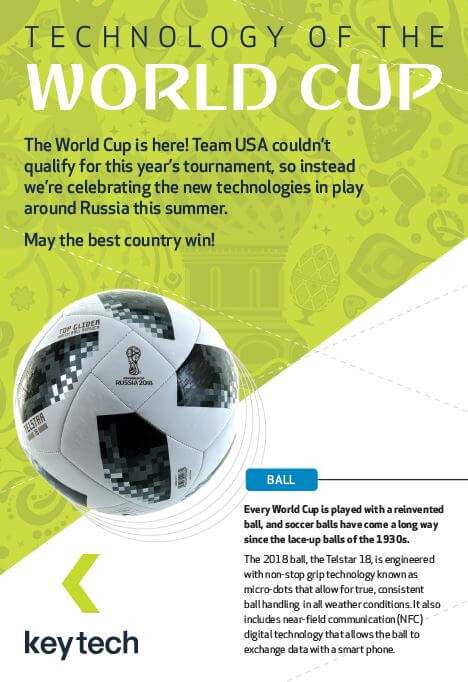21 Jun 5 Coolest Technologies in Play at the World Cup
With the World Cup in full swing, we thought it would be fun to look into the technology involved in the games.
- At 32 national teams, there’s a lot of feet on the fields! When we look to the feet – we have to acknowledge that we have come a long way since soccer cleats came online nearly a century ago. We explored the science of cleat shape where slight shifts can make the difference between winning and losing. Factors such as force-plate technology, computer analysis, and advanced materials to maximize an athlete’s performance, whether on natural grass or an artificial surface, are what’s driving today’s shoe and cleat design. Cleats are being designed to maximize a player’s potential, specific to the position played. The shoes themselves are made of different materials depending on the position, but cleat design and placement is engineered with the goal of maximizing required performance: speed, stability or quick moves. For example, angled studs in front for propulsion and chevrons in the heel for breaking. Or rotational traction for the ball of the foot with chevrons encircling, combined with half-conicals on the outside for quicker movement. We’ll even see anti-clog technology – water and mud repellant film – that help cleats release from the ground and stay ready for traction.1

- For the first time in the World Cup, Video Assistant Referee (VAR) technology will be used to allow referees to review certain situations in the game, such as whether a penalty was committed. FIFA has identified 4 incidents (3 main and one administrative) as game-changing uses of VAR. Goals: assisting the referee to determine whether there was an infringement, discounting the goal. Penalty Decisions: ensuring that no clearly wrong decisions are made with the award or non-award of a penalty kick. Direct Red Card Incidents: ensuring that no clearly wrong decisions are made in sending off or not sending off a player. And Mistaken Identity: informing the referee which player should be sanctioned if uncertainty exists. 2
- The 2018 World Cup Final will be played at the Luzhniki Stadium in Moscow, Russia and will feature the first ever SISGrass natural turf reinforced pitch with SISAir technology. The hybrid system actively manages moisture and provides considerably longer playing hours than natural grass surfaces, while the patented installation technology offers increased pitch stability. SIS Grass has 40% higher resilience compared to natural turf; 365 days maximum levelness – field integrity assurance, maximum stability; and uses state of the art yarn technology, not only maximizing players comfort but recyclable for environmental benefit. Installed with a custom laser system, it eliminates inherent human error in manual methods. 3
- Wearable performance trackers can record information such as field position, speed, run distance, heart rate, which can be used to help players train more efficiently. Germany used such tracker data to win the 2014 World Cup. Midfielder Mario Goetz became the only sub to score a winning goal in a World Cup game. Germany’s head coach relied on data from wearable trackers leading up to the game to make decisions on players and put Goetz into the game to shake up a stalemate.4
- Every World Cup is played with a reinvented ball, and soccer balls have come a long way since the lace-up balls of the 1930s. The 2018 ball, the Teslar 18, is engineered with non-stop grip technology known as micro-dots that allow for true, consistent ball handling in all weather conditions. It also includes near-field communication (NFC) digital technology that allows the ball to exchange data with a smartphone. NFC allows two devices to exchange data or trigger certain actions when physically connected to each other using radio frequency signals. The signals interact with the tag inside the ball, which for the Teslar 18 is passive, only sending information, and the mobile device can send and receive information.
The connection opens up the Teslar Experience in the NFC reading app. Exclusive information about the product, adidas football content, special competitions, and challenges, are shared. Features will be updated to keep people checking back. 5
While these technologies are exciting and compelling in their own right, we can’t help but envision the 2022 World Cup, with technology continuing to evolve at a rapid clip. At Key Tech, we are constantly pushing the envelope on new technology and technology integrations. Our staff soccer fans are numerous. Our visionaries foresee ball enabled optics for ground-level viewpoints; tech imbued jerseys for real-time bio-stats on our favorite players – upping the game; big data AI enhanced coaching apps; and robotic injury support devices that enable continued play.
If you are a product developer and want to explore technology integration – drop us a line, we love tough tech challenges. TalkToUs@KeyTechInc.com keytech-staging.akdreza8-liquidwebsites.com
2 https://football-technology.fifa.com/en/media-tiles/video-assistant-referee-var/
3 www.eurosportsturf.com/sis-grass/?lang=en
4 http://gadgetsandwearables.com/2018/02/02/soccer-training-sensor/
- Key Tech Welcomes New Hires - February 15, 2024
- Navigating Startup Challenges: An Interview with Dr. Deborah Hemingway - November 15, 2023
- 2023 Key Tech Summer Interns - September 19, 2023


